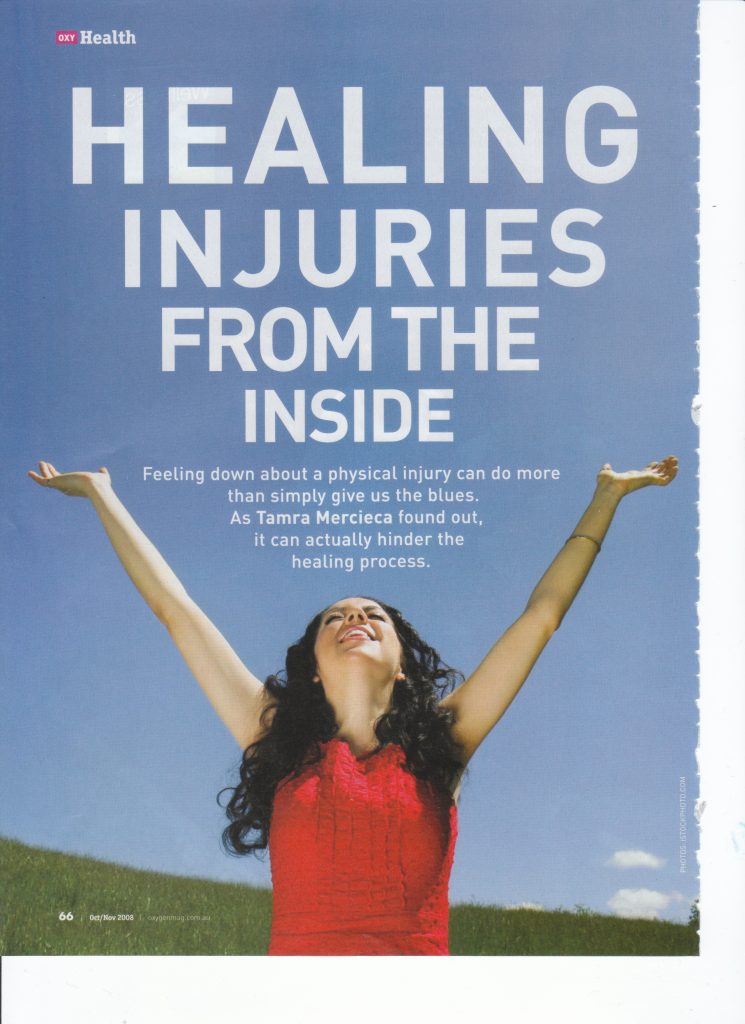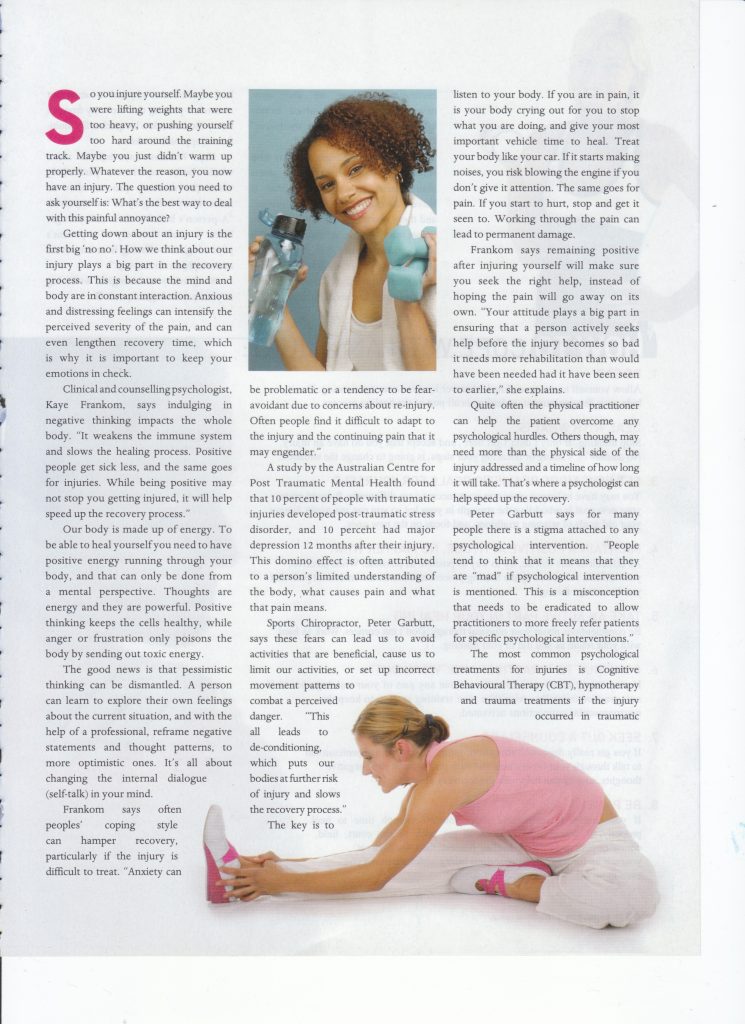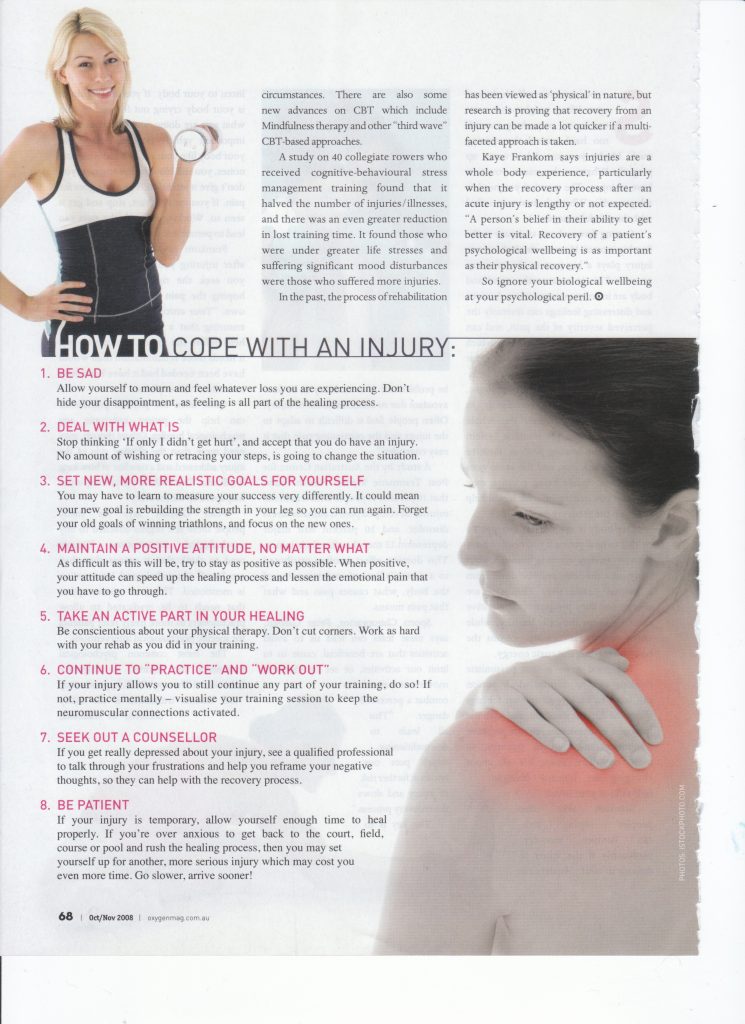


Healing injuries from the inside
Feeling down about a physical injury could do more than simply give us the blues. As Tamra Mercieca found out, if could actually hinder the healing process.
So you injure yourself. Maybe you were lifting weights that were too heavy, or pushing yourself too hard around the training track. Maybe you just didn’t warm up properly. Whatever the reason, you now have an injury. The question you need to ask yourself is: what’s the best way to deal with this painful annoyance?
Getting down about an injury is the first big ‘no no’. How we think about our injury, plays a big part in the recovery process. This is because the mind and body are in constant interaction. Anxious and distressing feelings can intensify the perceived severity of the pain, and can even lengthen recovery time, which is why it is important to keep your emotions in check.
Clinical and Counselling Psychologist, Kaye Frankom, says indulging in negative thinking impacts the whole body. “It weakens the immune system and slows the healing process. Positive people get sick less, and the same goes for injuries. While being positive may not stop you getting injured, it will help speed up the recovery process.”
Our body is made up of energy. To be able to heal yourself you need to have positive energy running through your body, and that can only be done from a mental perspective. Thoughts are energy and they are powerful. Positive thinking keeps the cells healthy, while anger or frustration only poisons the body, by sending out toxic energy.
The good news is that pessimistic thinking can be dismantled. A person can learn to explore their own feelings about the current situation, and with the help of a professional, reframe negative statements and thought patterns, to more optimistic ones. It’s all about changing the internal dialogue (self-talk) in your mind.
Frankom says often people’s coping style can hamper recovery particularly if the injury is difficult to treat. “Anxiety can be problematic or a tendency to be fear-avoidant due to concerns about re-injury. Often people find it difficult to adapt to the injury and the continuing pain that it may engender.”
A study by the Australian Centre for Post Traumatic Mental Health found that 10 percent of people with traumatic injuries developed post-traumatic stress disorder, and 10 percent had major depression 12 months after their injury. This domino effect is often attributed to a person’s limited understanding of the body and what causes pain and what that pain means.
Sports Chiropractor, Peter Garbutt, says these fears can lead us to avoid activities that are beneficial, cause us to limit our activities, or set up incorrect movement patterns to combat a perceived danger. “This all leads to de-conditioning, which puts our bodies at further risk of injury and slows the recovery process.”
The key is to listen to your body. If you are in pain, it is your body crying out for you to stop what you are doing, and give your most important vehicle time to heal. Treat your body like your car. If it starts making noises, you risk blowing the engine if you don’t give it attention. The same goes for pain. If you start to hurt, stop and get it seen to. Working through the pain can lead to permanent damage.
Frankom says remaining positive after injuring yourself will make sure you seek the right help, instead of hoping the pain will go away on its own. “Your attitude plays a big part in ensuring that a person actively seeks help, before the injury becomes so bad, it needs more rehabilitation than would have been needed had it have been seen to earlier.”
Quite often the physical practitioner can help the patient overcome any psychological hurdles. Others though, may need more than the physical side of the injury addressed and a timeline of how long it will take. That’s where a psychologist can help speed up the recovery.
Peter Garbutt says for many people there is a stigma attached to any psychological intervention. “People tend to think that it means that they are “mad” if psychological intervention is mentioned. This is a misconception that needs to be eradicated to allow practitioners to more freely refer patients for specific psychological interventions.”
The most common psychological treatments for injuries, is cognitive behavioural therapy (CBT) and hypnotherapy and trauma treatments if the injury occurred in traumatic circumstances. There are also some new advances on CBT which include Mindfulness therapy and other “third wave” CBT-based approaches.
A study on 40 collegiate rowers who received cognitive-behavioural stress management training found that it halved the number of injuries / illnesses, and there was an even greater reduction in lost training time. It found those who were under greater life stresses and suffering significant mood disturbances were those who suffered more injuries.
In the past, the process of rehabilitation has been viewed as ‘physical’ in nature, but research is proving that recovery from an injury can be made a lot quicker if a multi-faceted approach is taken.
Kaye Frankom says injuries are a whole body experience, particularly when the recovery process after an acute injury is lengthy or not expected. “A person’s belief in their ability to get better is vital. Recovery of a patient’s psychological wellbeing is as important as their physical recovery.”
So ignore your biological well-being at your psychological peril.
How to cope with an injury:
#1 BE SAD – Allow yourself to mourn and feel whatever loss you are experiencing. Don’t hide your disappointment, as feeling is all part of the healing process.
#2 DEAL WITH WHAT IS – Stop thinking ‘If only I didn’t get hurt’, and accept that you do have an injury. No amount of wishing, or retracing your steps, is going to change the situation.
#3 SET NEW, MORE REALISTIC GOALS FOR YOURSELF – You may have to learn to measure your success very differently. It could mean your new goal is rebuilding the strength in your leg so you can run again. Forget your old goals of winning triathlons, and focus on the new ones.
#4 MAINTAIN A POSITIVE ATTITUDE, NO MATTER WHAT – As difficult as this will be, try to stay as positive as possible. When positive, your attitude can speed up the healing process and lessen the emotional pain that you have to go through.
#5 TAKE AN ACTIVE PART IN YOUR HEALING – Be conscientious about your physical therapy. Don’t cut corners. Work as hard with your rehab as you did in your training.
#6 CONTINUE TO “PRACTICE” AND “WORK OUT” – If your injury allows you to still continue any part of your training, do so! If not, practice mentally – visualize your training session to keep the neuromuscular connections activated.
#7 SEEK OUT A COUNSELOR– If you get really depressed about your injury, see a qualified professional to talk through your frustrations and help you reframe your negative thoughts, so they can help with the recovery process.
#8 BE PATIENT– If your injury is temporary, allow yourself enough time to heal properly. If you’re over anxious to get back to the court, field, course or pool and rush the healing process, then you may set yourself up for another, more serious injury which may cost you even more time. Go slower, arrive sooner!
If you’d like to learn more about how the mind influences our physical health, you may like to have a listen to my free 1-hour audio lesson, by clicking here.
